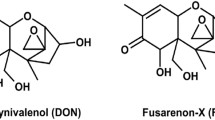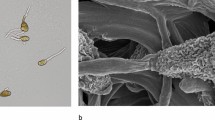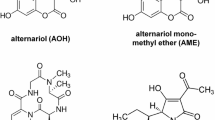Abstract
Occurrence of emerging mycotoxins in food and feed is reported worldwide, but studies on their toxic effects are still limited. Our previous study based on in silico approaches has evidenced an association between some cyclic peptidic mycotoxins and non-small cell lung cancer. In this work, an in vitro toxicological investigation of these mycotoxins (enniatin A, enniatin B, beauvericin, apicidin and destruxin B) was performed. Several pathways involved in lung cancer pathology, as revealed by the KEGG pathway map, were tested on A549 and NCI-H226 human lung cells. Effects on viability, apoptosis, cell cycle, DNA damage, reactive oxygen species, and IL-8 secretion were determined after 24-h mycotoxin treatment at concentrations between 0.01 and 100 µM. Enniatin A, beauvericin and apicidin presented a similar response for all endpoints. Moreover, they were the most toxic compounds, with IC50 around 2.2 and 13.1 µM, and apoptosis induction in both cell lines. Enniatin B did not induce a complete decrease in cell viability and did not provoke apoptosis. Destruxin B increased caspase 3 activity and altered cell cycle at concentrations above 6.25 µM in A549 cells, suggesting apoptosis activation, although it did not reduce cell viability in either cell line. Finally, enniatins A and B, apicidin, beauvericin and destruxin B increased the release of the pro-inflammatory IL-8. The in vitro results of this work confirmed the prediction using in silico approaches as some hallmarks of cancer can be observed after treatment of lung cells with this mycotoxin cluster. The toxic effects observed in human lung cells confirmed that the presence of these emerging mycotoxins in agricultural products, food and feed might be hazardous for human health and that a link with lung cancer was further outlined for three of them.











Similar content being viewed by others
Availability of data and material
Not applicable.
Code availability
Not applicable.
References
Agahi F, Álvarez-Ortega N, Font G, Juan-García A, Juan C (2020) Oxidative stress, glutathione, and gene expression as key indicators in SH-SY5Y cells exposed to zearalenone metabolites and beauvericin. Toxicol Lett 334:44–52. https://doi.org/10.1016/j.toxlet.2020.09.011
Agriopoulou S, Stamatelopoulou E, Varzakas T (2020) Advances in occurrence, importance, and mycotoxin control strategies: prevention and detoxification in foods. Foods 9:137. https://doi.org/10.3390/foods9020137
Ahn M-Y (2018) HDAC inhibitor apicidin suppresses murine oral squamous cell carcinoma cell growth in vitro and in vivo via inhibiting HDAC8 expression. Oncol Lett 16:6552–6560. https://doi.org/10.3892/ol.2018.9468
Albonico M, Spicer L, Cortinovis C, Schutz LF, Caloni F (2015) In vitro toxicological effects of Fumonisin B1 and Beauvericin on bovine granulosa cells. Int J Health Anim Sci Food Saf. https://doi.org/10.13130/2283-3927/5039
Albonico M, Cortinovis C, Caloni F (2016) In vitro toxicity of beauvericin alone and combined with fumonisin B1 or deoxynivalenol on Caco-2 cells. Int J Health Anim Sci Food Saf. https://doi.org/10.13130/2283-3927/7089
Alonso-Garrido M, Escrivá L, Manyes L, Font G (2018) Enniatin B induces expression changes in the electron transport chain pathway related genes in lymphoblastic T-cell line. Food Chem Toxicol 121:437–443. https://doi.org/10.1016/j.fct.2018.09.018
Awuchi CG, Ondari EN, Ogbonna CU, Upadhyay AK, Baran K, Okpala COR, Korzeniowska M, Guiné RPF (2021) Mycotoxins affecting animals, foods, humans, and plants: types, occurrence, toxicities, action mechanisms, prevention, and detoxification strategies—a revisit. Foods 10:1279. https://doi.org/10.3390/foods10061279
Awuchi CG, Ondari EN, Nwozo S, Odongo GA, Eseoghene IJ, Twinomuhwezi H, Ogbonna CU, Upadhyay AK, Adeleye AO, Okpala COR (2022) Mycotoxins’ toxicological mechanisms involving humans, livestock and their associated health concerns: a review. Toxins (basel) 14:167. https://doi.org/10.3390/toxins14030167
Azman NI, Wan-Mustapha WN, Goh YM, Hassim HA, Selamat J, Samsudin NIP (2021) Climatic conditions and farm practices affected the prevalence of Aspergillus section Flavi on different types of dairy goat’s feed. Int J Food Microbiol 347:109205. https://doi.org/10.1016/j.ijfoodmicro.2021.109205
Behm C, Föllmann W, Degen GH (2012) Cytotoxic potency of mycotoxins in cultures of V79 lung fibroblast cells. J Toxicol Environ Health A 75:1226–1231. https://doi.org/10.1080/15287394.2012.709170
Brasel TL, Martin JM, Carriker CG, Wilson SC, Straus DC (2005) Detection of airborne Stachybotrys chartarum macrocyclic trichothecene mycotoxins in the indoor environment. Appl Environ Microbiol 71:7376–7388. https://doi.org/10.1128/AEM.71.11.7376-7388.2005
Brera C, Caputi R, Miraglia M, Iavicoli I, Salerno A, Carelli G (2002) Exposure assessment to mycotoxins in workplaces: aflatoxins and ochratoxin A occurrence in airborne dusts and human sera. Microchem J 73:167–173. https://doi.org/10.1016/S0026-265X(02)00061-9
Carstens KE, Carpenter AF, Martin MM, Harrill JA, Shafer TJ, Paul Friedman K (2022) Integrating data from in vitro new approach methodologies for developmental neurotoxicity. Toxicol Sci 187:62–79. https://doi.org/10.1093/toxsci/kfac018
Chen S, Chen M (2022) Schwann cells promote the migration and invasion of colorectal cancer cells via the activated NF-κB/IL-8 axis in the tumor microenvironment. Front Oncol 12:1026670. https://doi.org/10.3389/fonc.2022.1026670
Cui G, Wang Z, Liu H, Pang Z (2022) Cytokine-mediated crosstalk between cancer stem cells and their inflammatory niche from the colorectal precancerous adenoma stage to the cancerous stage: mechanisms and clinical implications. Front Immunol 13:1057181. https://doi.org/10.3389/fimmu.2022.1057181
Dvorácková I (1976) Aflatoxin inhalation and alveolar cell carcinoma. Br Med J 1:691. https://doi.org/10.1136/bmj.1.6011.691
Dvorácková I, Píchová V (1986) Pulmonary interstitial fibrosis with evidence of aflatoxin B1 in lung tissue. J Toxicol Environ Health 18:153–157. https://doi.org/10.1080/15287398609530856
Escher SE, Kamp H, Bennekou SH, Bitsch A, Fisher C, Graepel R, Hengstler JG, Herzler M, Knight D, Leist M, Norinder U, Ouédraogo G, Pastor M, Stuard S, White A, Zdrazil B, van de Water B, Kroese D (2019) Towards grouping concepts based on new approach methodologies in chemical hazard assessment: the read-across approach of the EU-ToxRisk project. Arch Toxicol 93:3643–3667. https://doi.org/10.1007/s00204-019-02591-7
Flannigan B (1987) Mycotoxins in the air. Int Biodeterior 23:73–78. https://doi.org/10.1016/0265-3036(87)90029-7
Fraeyman S, Meyer E, Devreese M, Antonissen G, Demeyere K, Haesebrouck F, Croubels S (2018) Comparative in vitro cytotoxicity of the emerging Fusarium mycotoxins beauvericin and enniatins to porcine intestinal epithelial cells. Food Chem Toxicol 121:566–572. https://doi.org/10.1016/j.fct.2018.09.053
Garcia-Cela E, Kiaitsi E, Medina A, Sulyok M, Krska R, Magan N (2018) Interacting environmental stress factors affects targeted metabolomic profiles in stored natural wheat and that inoculated with F. graminearum. Toxins (basel) 10:E56. https://doi.org/10.3390/toxins10020056
Georggiett OC, Muiño JC, Montrull H, Brizuela N, Avalos S, Gómez RM (2000) Relationship between lung cancer and aflatoxin B1. Rev Fac Cien Med Univ Nac Cordoba 57:95–107
Goldblatt LA (1972) Implications of mycotoxins. Clin Toxicol 5:453–464. https://doi.org/10.3109/15563657208991026
González-Jartín JM, Rodríguez-Cañás I, Alfonso A, Sainz MJ, Vieytes MR, Gomes A, Ramos I, Botana LM (2021) Multianalyte method for the determination of regulated, emerging and modified mycotoxins in milk: QuEChERS extraction followed by UHPLC-MS/MS analysis. Food Chem 356:129647. https://doi.org/10.1016/j.foodchem.2021.129647
Habauzit D, Lemée P, Botana LM, Fessard V (2022) Toxicity predictions for mycotoxins: a combined in silico approach on enniatin-like cluster. Expo Health. https://doi.org/10.1007/s12403-022-00492-2
Hayes RB, van Nieuwenhuize JP, Raatgever JW, ten Kate FJ (1984) Aflatoxin exposures in the industrial setting: an epidemiological study of mortality. Food Chem Toxicol 22:39–43. https://doi.org/10.1016/0278-6915(84)90050-4
Hintikka E, Holopainen R, Asola A, Jestoi M, Peitzsch M, Kalso S, Larsson L, Reijula K, Tuomi T (2009) Mycotoxins in the ventilation systems of four schools in Finland. World Mycotoxin J. https://doi.org/10.3920/WMJ2009.1155
Huang Liu R, Chen S-P, Lu T-M, Tsai W-Y, Tsai C-H, Yang C-C, Tzeng Y-M (2014) Selective apoptotic cell death effects of oral cancer cells treated with destruxin B. BMC Complement Altern Med 14:207. https://doi.org/10.1186/1472-6882-14-207
Huang CH, Wang FT, Chan WH (2022) Enniatin B induces dosage-related apoptosis or necrosis in mouse blastocysts leading to deleterious effects on embryo development, Drug and Chemical Toxicology, 45:4, 1449–1460. https://doi.org/10.1080/01480545.2020.1838537
Huttunen K, Korkalainen M (2017) Microbial secondary metabolites and knowledge on inhalation effects. In: Viegas C, Viegas S, Gomes A, Täubel M, Sabino R (eds) Exposure to microbiological agents in indoor and occupational environments. Springer International Publishing, Cham, pp 213–234. https://doi.org/10.1007/978-3-319-61688-9_10
Izzo L, Mikušová P, Lombardi S, Sulyok M, Ritieni A (2022) Analysis of mycotoxin and secondary metabolites in commercial and traditional Slovak cheese samples. Toxins (basel) 14:134. https://doi.org/10.3390/toxins14020134
Jakšić D, Sertić M, Kifer D, Kocsubè S, Mornar Turk A, Nigović B, Šarkanj B, Krska R, Sulyok M, Šegvić Klarić M (2021) Fungi and their secondary metabolites in water-damaged indoors after a major flood event in eastern Croatia. Indoor Air 31:730–744. https://doi.org/10.1111/ina.12777
Jalili P, Krause B-C, Lanceleur R, Burel A, Jungnickel H, Lampen A, Laux P, Luch A, Fessard V, Hogeveen K (2022) Chronic effects of two rutile TiO2 nanomaterials in human intestinal and hepatic cell lines. Part Fibre Toxicol 19:37. https://doi.org/10.1186/s12989-022-00470-1
Kanehisa M, Goto S (2000) KEGG: kyoto encyclopedia of genes and genomes. Nucleic Acids Res 28:27–30. https://doi.org/10.1093/nar/28.1.27
Khoshal AK, Novak B, Martin PGP, Jenkins T, Neves M, Schatzmayr G, Oswald IP, Pinton P (2019) Co-occurrence of DON and emerging mycotoxins in worldwide finished pig feed and their combined toxicity in intestinal cells. Toxins (basel) 11:E727. https://doi.org/10.3390/toxins11120727
Kim YK, Lee EK, Kang JK, Kim JA, You J-S, Park JH, Seo D-W, Hwang JW, Kim S-N, Lee HY, Lee HW, Han J-W (2006a) Activation of NF-kappaB by HDAC inhibitor apicidin through Sp1-dependent de novo protein synthesis: its implication for resistance to apoptosis. Cell Death Differ 13:2033–2041. https://doi.org/10.1038/sj.cdd.4401915
Kim YK, Seo D-W, Kang D-W, Lee HY, Han J-W, Kim S-N (2006b) Involvement of HDAC1 and the PI3K/PKC signaling pathways in NF-kappaB activation by the HDAC inhibitor apicidin. Biochem Biophys Res Commun 347:1088–1093. https://doi.org/10.1016/j.bbrc.2006.06.196
Krug I, Behrens M, Esselen M, Humpf H-U (2018) Transport of enniatin B and enniatin B1 across the blood-brain barrier and hints for neurotoxic effects in cerebral cells. PLoS ONE 13:e0197406. https://doi.org/10.1371/journal.pone.0197406
Kumar S, O’Malley J, Chaudhary AK, Inigo JR, Yadav N, Kumar R, Chandra D (2019) Hsp60 and IL-8 axis promotes apoptosis resistance in cancer. Br J Cancer 121:934–943. https://doi.org/10.1038/s41416-019-0617-0
Limay-Rios V, Schaafsma AW (2021) Relationship between mycotoxin content in winter wheat grain and aspirated dust collected during harvest and after storage. ACS Omega 6:1857–1871. https://doi.org/10.1021/acsomega.0c04256
Lin H-I, Lee Y-J, Chen B-F, Tsai M-C, Lu J-L, Chou C-J, Jow G-M (2005) Involvement of Bcl-2 family, cytochrome c and caspase 3 in induction of apoptosis by beauvericin in human non-small cell lung cancer cells. Cancer Lett 230:248–259. https://doi.org/10.1016/j.canlet.2004.12.044
Liu C, Van der Fels-Klerx HJ (2021) Quantitative modeling of climate change impacts on mycotoxins in cereals: a review. Toxins (basel) 13:276. https://doi.org/10.3390/toxins13040276
Lu C-L, Lin H-I, Chen B-F, Jow G-M (2016) Beauvericin-induced cell apoptosis through the mitogen-activated protein kinase pathway in human nonsmall cell lung cancer A549 cells. J Toxicol Sci 41:429–437. https://doi.org/10.2131/jts.41.429
Medina Á, González-Jartín JM, Sainz MJ (2017) Impact of global warming on mycotoxins. Curr Opin Food Sci Food Toxicol Food Saf 18:76–81. https://doi.org/10.1016/j.cofs.2017.11.009
Ndaw S, Jargot D, Antoine G, Denis F, Melin S, Robert A (2021) Investigating multi-mycotoxin exposure in occupational settings: a biomonitoring and airborne measurement approach. Toxins (basel). https://doi.org/10.3390/toxins13010054
Olsen JH, Dragsted L, Autrup H (1988) Cancer risk and occupational exposure to aflatoxins in Denmark. Br J Cancer 58:392–396. https://doi.org/10.1038/bjc.1988.226
Ookawara T, Aihara R, Morimoto A, Iwashita N, Kurata K, Takagi Y, Miyasaka A, Kushiro M, Miyake S, Fukuyama T (2021) Acute and subacute oral toxicity of deoxynivalenol exposure in a Dermatophagoides farinae-induced murine asthma model. Toxicol Sci 179:229–240. https://doi.org/10.1093/toxsci/kfaa168
Park H, Im JY, Kim J, Choi WS, Kim HS (2008) Effects of apicidin, a histone deacetylase inhibitor, on the regulation of apoptosis in H-ras-transformed breast epithelial cells. Int J Mol Med 21:325–333
Pérez-Fuentes N, Alvariño R, Alfonso A, González-Jartín J, Gegunde S, Vieytes MR, Botana LM (2021) Single and combined effects of regulated and emerging mycotoxins on viability and mitochondrial function of SH-SY5Y cells. Food Chem Toxicol 154:112308. https://doi.org/10.1016/j.fct.2021.112308
Pleadin J, Frece J, Markov K (2019) Mycotoxins in food and feed. Adv Food Nutr Res 89:297–345. https://doi.org/10.1016/bs.afnr.2019.02.007
Pócsi I, Giacometti F, Ambrus Á, Logrieco AF (2020) Editorial: aspergillus-derived mycotoxins in the feed and food chain. Front Microbiol 11:606108. https://doi.org/10.3389/fmicb.2020.606108
Prosperini A, Juan-García A, Font G, Ruiz MJ (2013) Reactive oxygen species involvement in apoptosis and mitochondrial damage in Caco-2 cells induced by enniatins A, A1, B and B1. Toxicol Lett 222:36–44. https://doi.org/10.1016/j.toxlet.2013.07.009
Rocchetti G, Ghilardelli F, Masoero F, Gallo A (2021) Screening of regulated and emerging mycotoxins in bulk milk samples by high-resolution mass spectrometry. Foods 10:2025. https://doi.org/10.3390/foods10092025
Skóra J, Matusiak K, Wojewódzki P, Nowak A, Sulyok M, Ligocka A, Okrasa M, Hermann J, Gutarowska B (2016) Evaluation of microbiological and chemical contaminants in poultry farms. Int J Environ Res Public Health 13:192. https://doi.org/10.3390/ijerph13020192
Søderstrøm S, Lie KK, Lundebye A-K, Søfteland L (2022) Beauvericin (BEA) and enniatin B (ENNB)-induced impairment of mitochondria and lysosomes—potential sources of intracellular reactive iron triggering ferroptosis in Atlantic salmon primary hepatocytes. Food Chem Toxicol 161:112819. https://doi.org/10.1016/j.fct.2022.112819
Straumfors A, Uhlig S, Eriksen GS, Heldal KK, Eduard W, Krska R, Sulyok M (2015) Mycotoxins and other fungal metabolites in grain dust from Norwegian grain elevators and compound feed mills. World Mycotoxin J 8:361–373. https://doi.org/10.3920/WMJ2014.1799
Straumfors A, Mundra S, Foss OAH, Mollerup SK, Kauserud H (2021) The airborne mycobiome and associations with mycotoxins and inflammatory markers in the Norwegian grain industry. Sci Rep 11:9357. https://doi.org/10.1038/s41598-021-88252-1
Sulyok M, Stadler D, Steiner D, Krska R (2020) Validation of an LC-MS/MS-based dilute-and-shoot approach for the quantification of > 500 mycotoxins and other secondary metabolites in food crops: challenges and solutions. Anal Bioanal Chem 412:2607–2620. https://doi.org/10.1007/s00216-020-02489-9
Szulc J, Okrasa M, Dybka-Stępień K, Sulyok M, Nowak A, Otlewska A, Szponar B, Majchrzycka K (2020) Assessment of microbiological indoor air quality in cattle breeding farms. Aerosol Air Qual Res 20:1353–1373. https://doi.org/10.4209/aaqr.2019.12.0641
Szulc J, Okrasa M, Majchrzycka K, Sulyok M, Nowak A, Ruman T, Nizioł J, Szponar B, Gutarowska B (2021) Microbiological and toxicological hazards in sewage treatment plant bioaerosol and dust. Toxins 13:691. https://doi.org/10.3390/toxins13100691
Taibon J, Sturm S, Seger C, Strasser H, Stuppner H (2015) Quantitative assessment of destruxins from strawberry and maize in the lower parts per billion range: combination of a QuEChERS-based extraction protocol with a fast and selective UHPLC-QTOF-MS assay. J Agric Food Chem 63:5707–5713. https://doi.org/10.1021/acs.jafc.5b01562
Täubel M, Sulyok M, Vishwanath V, Bloom E, Turunen M, Järvi K, Kauhanen E, Krska R, Hyvärinen A, Larsson L, Nevalainen A (2011) Co-occurrence of toxic bacterial and fungal secondary metabolites in moisture-damaged indoor environments. Indoor Air 21:368–375. https://doi.org/10.1111/j.1600-0668.2011.00721.x
Viegas S, Viegas C, Oppliger A (2018) Occupational exposure to mycotoxins: current knowledge and prospects. Ann Work Expo Health 62:923–941. https://doi.org/10.1093/annweh/wxy070
Watford S, Edwards S, Angrish M, Judson RS, Paul Friedman K (2019) Progress in data interoperability to support computational toxicology and chemical safety evaluation. Toxicol Appl Pharmacol 380:114707. https://doi.org/10.1016/j.taap.2019.114707
Wätjen W, Debbab A, Hohlfeld A, Chovolou Y, Kampkötter A, Edrada RA, Ebel R, Hakiki A, Mosaddak M, Totzke F, Kubbutat MHG, Proksch P (2009) Enniatins A1, B and B1 from an endophytic strain of Fusarium tricinctum induce apoptotic cell death in H4IIE hepatoma cells accompanied by inhibition of ERK phosphorylation. Mol Nutr Food Res 53:431–440. https://doi.org/10.1002/mnfr.200700428
Wong J, Magun BE, Wood LJ (2016) Lung inflammation caused by inhaled toxicants: a review. Int J Chron Obstruct Pulmon Dis 11:1391–1401. https://doi.org/10.2147/COPD.S106009
Wu C-C, Chen T-H, Liu B-L, Wu L-C, Chen Y-C, Tzeng Y-M, Hsu S-L (2013) Destruxin B isolated from entomopathogenic fungus metarhizium anisopliae induces apoptosis via a Bcl-2 family-dependent mitochondrial pathway in human nonsmall cell lung cancer cells. Evid Based Complement Alternat Med 2013:548929. https://doi.org/10.1155/2013/548929
Zhang Y, Wang L, Zhang M, Jin M, Bai C, Wang X (2012) Potential mechanism of interleukin-8 production from lung cancer cells: an involvement of EGF-EGFR-PI3K-Akt-Erk pathway. J Cell Physiol 227:35–43. https://doi.org/10.1002/jcp.22722
Funding
The research leading to these results has received funding from the following FEDER cofunded-grants, from Conselleria de Cultura, Educacion e Ordenación Universitaria, Xunta de Galicia, GRC (ED431C 2021/01), from European Union Interreg Agritox EAPA-998-2018, and H2020 778069-EMERTOX, and from Ministerio de Ciencia e Innovación IISCIII/PI19/001248, PID 2020-11262RB-C21. N.P-F. is supported by a fellowship from FIDIS, Spain. R. A. is supported by a postdoctoral fellowship from Xunta de Galicia (ED481B-2021-038), Spain. This work was supported by ANSES.
Author information
Authors and Affiliations
Contributions
All authors contributed to the study conception and design. Material preparation, data collection and analysis were performed by Denis Habauzit, Rebeca Alvariño, Nadia Pérez-Fuentes and Sylvie Huet. The first draft of the manuscript was written by Denis Habauzit and Rebeca Alvariño and all authors commented on preliminary versions of the manuscript. Denis Habauzit and Rebeca Alvariño contributed equally to this work. All authors read and approved the final manuscript.
Corresponding author
Ethics declarations
Permission
Not applicable.
Conflict of interest
The authors declare that they have no competing interests.
Additional declarations for articles in life science journals that report the results of studies involving humans and/or animals
Not applicable.
Ethics approval
Not applicable.
Consent to participate
Not applicable.
Consent for publication
Not applicable.
Additional information
Publisher's Note
Springer Nature remains neutral with regard to jurisdictional claims in published maps and institutional affiliations.
Rights and permissions
Springer Nature or its licensor (e.g. a society or other partner) holds exclusive rights to this article under a publishing agreement with the author(s) or other rightsholder(s); author self-archiving of the accepted manuscript version of this article is solely governed by the terms of such publishing agreement and applicable law.
About this article
Cite this article
Habauzit, D., Alvariño, R., Pérez-Fuentes, N. et al. In Vitro Testing of Lung Carcinogenicity for an In Silico-Identified Cluster of Mycotoxins. Expo Health (2023). https://doi.org/10.1007/s12403-023-00601-9
Received:
Revised:
Accepted:
Published:
DOI: https://doi.org/10.1007/s12403-023-00601-9




